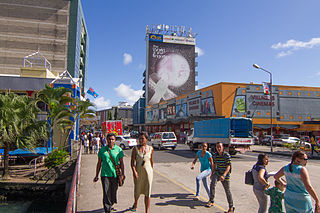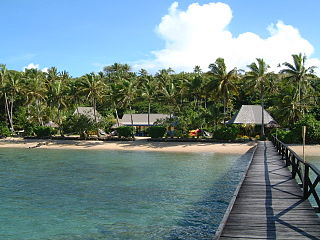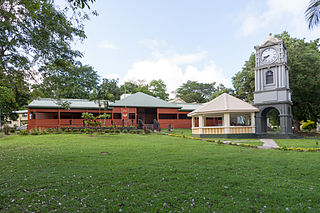Related Research Articles

Suva is the capital and largest city of Fiji. It is the home of the country's largest metropolitan area and serves as its major port. The city is located on the southeast coast of the island of Viti Levu, in Rewa Province, Central Division.

Fiji is a group of volcanic islands in the South Pacific, lying about 4,450 kilometres (2,765 mi) southwest of Honolulu and 1,770 km (1,100 mi) north of New Zealand. Of the 332 islands and 522 smaller islets making up the archipelago, about 106 are permanently inhabited. The total land size is 18,272 km2 (7,055 sq mi). It has the 26th largest Exclusive Economic Zone of 1,282,978 km2 (495,361 sq mi).

Vanua Levu, formerly known as Sandalwood Island, is the second largest island of Fiji. Located 64 kilometres to the north of the larger Viti Levu, the island has an area of 5,587.1 square kilometres (2,157.2 sq mi) and a population of 135,961 as of 2007.

Viti Levu is the largest island in the Republic of Fiji. It is the site of the nation's capital, Suva, and home to a large majority of Fiji's population.
Burebasaga is the largest of the three confederacies that make up Fiji's House of Chiefs, to which some of the Fijian chiefs belong.

The Rewa River is the longest and widest river in Fiji. Located on the island of Viti Levu, the Rewa originates in Tomanivi, the highest peak in Fiji, and flows southeast for 145 km to Laucala Bay, near Suva. The Rewa River drains approximately one-third of Viti Levu.

The Central Division of Fiji is one of Fiji's four divisions. It consists of five provinces - Naitasiri, Namosi, Rewa, Serua and Tailevu.

Ovalau is the sixth largest island in Fiji. It is located in Lomaiviti Archipelago. Situated at 17.70° South and 178.8° East,, the island is about 13 kilometers long and 10 kilometers wide. It covers a total area of 106.4 square kilometers and has a population of around 9,100, approximately half of the population of Lomaiviti Province over the 1956–2007 period. Levuka, Fiji's former capital, is the largest of 24 towns and villages on the island, and is the only urban area in Lomaiviti. All settlements are coastal, except Lovoni in the interior of the island.

Rakiraki is a district in Fiji's Ra Province. It is located between Tavua and Korovou when travelling along the Kings Road, on the northern coast of Viti Levu, Fiji's largest island.

Nananu-i-Ra is an island in Fiji about 3 kilometers off the north coast of the main island of Viti Levu, near the town of Rakiraki in Ra Province. The island is 3.5 square kilometers and has a maximum elevation of 180 meters. The name "Nananu-I-Ra" means "Daydream of the West" in Fijian. Fijian mythology holds that Nananu-I-Ra is the point of departure for disembodied spirits leaving this world for the afterlife.
Naitasiri is one of the 14 provinces of Fiji and one of eight located on Viti Levu, Fiji's largest island.

The Diocese of Polynesia, or the Tikanga Pasefika serves Anglicans in Fiji, Tonga, Samoa and the Cook Islands, within the Anglican Church in Aotearoa, New Zealand and Polynesia. The diocese's first bishop was consecrated in 1908. The diocese's cathedral is Holy Trinity Cathedral in Suva, Fiji.

The Roman Catholic Archdiocese of Suva is a Metropolitan Archdiocese in Fiji. It is responsible for the suffragan dioceses of Rarotonga and Tarawa and Nauru and —as of 21 March 2003—the Mission Sui Iuris of Funafuti. The archdiocese was created in 1966, to succeed the Apostolic Vicariate of Fiji.

The pink-billed parrotfinch is a species of estrildid finch found on the island of Viti Levu, Fiji. Commonly found at undisturbed mature forest in the centre and east of Viti Levu, e.g. Joske's Thumb near Suva. This species is found at mid-height along tree-trunks and branches, usually alone or in pairs but also joining mixed-species flocks, feeding primarily on insects, but also on flower buds and fruits.

The Sigatoka River is in the island of Viti Levu in Fiji and has its source on the west side of Mount Victoria and flows for 120 kilometers to the coast between the central and western ranges. It is the chief means of transportation with some parts of the interior of the island.

The Navua River is located in the island of Viti Levu in Fiji and has its source on the south east slope of Mount Gordon and flows for 65 kilometers to the south coast. It is noted for the rugged mountain country through which it flows. In the late 19th century, a sugar mill was built on the banks of this river, and although the mill was shut down in 1923, the town of Navua stands on its site.
The Fiji School of Medicine is a tertiary institution based in Suva, Fiji. Originally established in 1885 as the Suva Medical School. FSM became the College of Medicine, Nursing & Health Sciences as part of Fiji National University in 2010. It is located on the main island of Viti Levu in the Fiji Islands.

The Fiji Museum is a museum in Suva, Fiji located in the capital city's botanical gardens, Thurston Gardens.
The 1953 Suva earthquake occurred on 14 September at 00:26 UTC near Suva, Fiji, just off the southeast shore of Viti Levu. This earthquake had an estimated magnitude of Ms 6.8 and Mw 6.4. The earthquake triggered a coral reef platform collapse and a submarine landslide that caused a tsunami. Eight people were reported killed; a wharf, bridges, and buildings were severely damaged in Suva.

Naval Base Fiji was a naval base built by the United States Navy in 1942 to support the World War II effort. The base was located on Fiji in the Central Pacific Ocean. The base was built as one of many advance bases in the island-hopping campaign towards the Empire of Japan. The US Navy built seaports, seaplane bases and airfields used for staging in the Pacific War.
References
- ↑ Steve Solomon; Jens Kruger (December 1996). "Vulnerability and Adaptation Assessment - Coastal Impact of Sea-Level Change: Suva and Vicinity, Viti Levu, Fiji Islands" (PDF). p. 12. Retrieved 23 July 2014.
18°08′S178°28′E / 18.133°S 178.467°E